#i'm talking about the golden era of flemish art
Text
I really envy you european folks, you have the important art paintings just around the corner
#the flemish masters#i'm talking about the golden era of flemish art#you have the museums there#and what do i have? a YouTube documentary on an android screen#ah and the useless nationalism art murals on my country ._.#and the talentless and overrated frida
3 notes
·
View notes
Note
Hiya!
Love your blog! So much cool info here. I don't know if this is the kind of thing you are interested in or know much about but I'm making a cosplay of Mary from the BBC Ghosts. She supposedly died in the early 17th century but I can't find anything on the blue bodice/waistcoat she is wearing. I think it is closer to 19th century stays? Anyway, I get it's not 100% historically accurate costume, just wondering. Thanks!
Hi, Anon! And thank you so much!
I haven't watched the show, but I checked out the outfit and here it is for those who also didn't know it before:

A quick look at the Ghosts wikipage of her tells she was an English peasant.
I ended up falling into a bit of research rabbit hole (which is why it took me this long to answer). The evolution of working class garments from Elizabethan era to 1700s ended up being very interesting and surprisingly complicated. It doesn't make it easier that there's very little info on the subject, especially regarding English working class. It's much easier to find info on Dutch and Flemish working class clothing, as the Dutch golden age/baroque art was very interested in depicting working class people, the style also provides abundance of detail. English artists were much less interested in painting common people.
To make the rest make any sense I think it would be useful to outline the evolution of garments used in 16th to 18th century. In 1500s kirtle (here's a post where I talk about what kirtle is and it's evolutiona mong other things) was becoming more and more structured, eventually it's bodice becoming fully boned. Lower classes wouldn't bone their kirtles but reinforce them with several layers of canvas or buckram. In the first half of the century a short wool coat was sometimes used under the outerwear far warmed called petticoat. It was the Little Ice Age after all. Two boned or highly stiffened kirtles started to be used on top of each other, the first layer being made from cheaper materials and acting as the actual supporting layer, and the one on top of it from more expensive materials, stiffening (not necessarily boning) making sure the fabric is structured and without wrinkles. In the latter half of the century petticoat started to refer to the undergarment kirtle. Petticoats usually were a full dress like kirtle, though there's references of "petticoats without the upper bodies" so petticoats with only the skirt were also used as undergarments.
It gained the connotation of a simple and not very fancy garment, which is why the lower class kirtles started to be called petticoats by late 1500s. Lower classes might also wear two layers of petticoats, often in contrasting colors, probably in cold weather and then one layer in hot weather. The bodice and skirt also could be contrasting colors. The outer petticoat had almost always lacing in the front, but the petticoat under it might have lacing in the back or side so it's fabric could be seen under the lacing over it. At least Dutch and Flemish women would usually have a stomacher of contrasting color under the front lacing if they didn't have a petticoat under. Very wide lacing which showed off the fabric beneath was typical (but not necessary) for those and the German speaking areas. Petticoats would often have attachable or sewn-in sleeves like kirtles since Middle Ages, so that they could be worn as undergarment without sleeves and outer garment with sleeves if necessary.
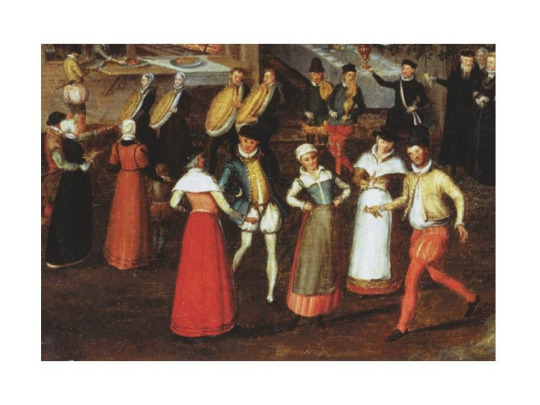
An example from 1570s England. Two of the three peasant women in the front are wearing petticoats with bodices made from different fabrics.

An example by Flemish painter from around 1560s/70s. The left-most woman is clearly wearing a soft stomacher under her petticoat and the woman in the very middle has attached sleeves as shown by the bulging shift in her arm pits.
Over the petticoats though working class women would often wear a looser sleeved over-garment which wasn't laced. Around Netherlands area it was a short jacket with widening hem at waist often called waistcoat, like on the right-most woman in above painting, though I'm not sure if that is actually contemporary term for it. In late 1500s England the over-garment seemed to be more commonly a full length gown open in the front with short or full sleeves, similarly as the fashionable outer garment of the upper classes but much simpler, but by early 1600s the waistcoat is most commonly depicted in England too. There were couple of important accessories. Partlet was in 1600s most often white linen, while in the earlier century woolen black partlets were also common (the woman in the middle of the Flemish painting above is wearing both). In 1500s and early half of 1600s the partlet had high collar with ruffle like shown in the above paintings and it was usually worn over the petticoat (though sometimes under) and under the waistcoat or similar over-garment. Apron was also very important for working women, and while most often it was white linen, wool and different colors like show in both paintings above were also common. Kercief, a (most often) white linen scarf pinned on shoulders, was also common, especially in England, as shown in the first painting and the one below.
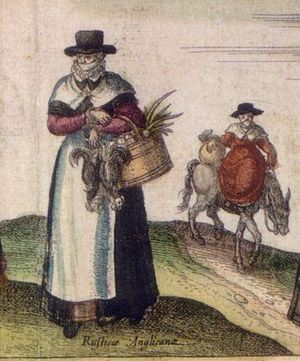
An English peasant from 1582 illustration wearing an open-fronted over-gown with short sleeves.
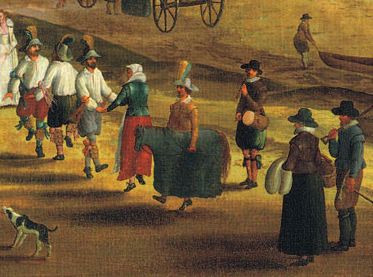
English peasants dancing from 1620s, while the women are wearing waistcoats.
In the fashion of the upper classes the bodice of the petticoat and the skirt of the petticoat started to appear as separate garments in late 1500s. A separate bodice was referred to as pair of bodies, or bodies, similarly to the bodice of the petticoat was referred to as upper bodies like I mentioned before. The word bodice actually derives from it. For clarity I will call the separate boned bodice as bodies. Like petticoat it was very much an undergarment, though could be used as a leisure wear in private. Like other supportive clothing that could be used as both under and over garments it also often had detachable sleeves. The full petticoat would fall out of use by the upper class by mid 1600s, but bodies wouldn't become universal as the structural layer yet, as the outer gown's bodice would often still be boned and used as the supportive layer. Working class women would use full petticoats till late 1600s, but separate bodies would become more widespread from early to mid century onward. Boning also would get adopted into working class clothing around mid century, though stiffening with fabrics or barely at all would continue to be common the whole century and still continue till early 1700s.
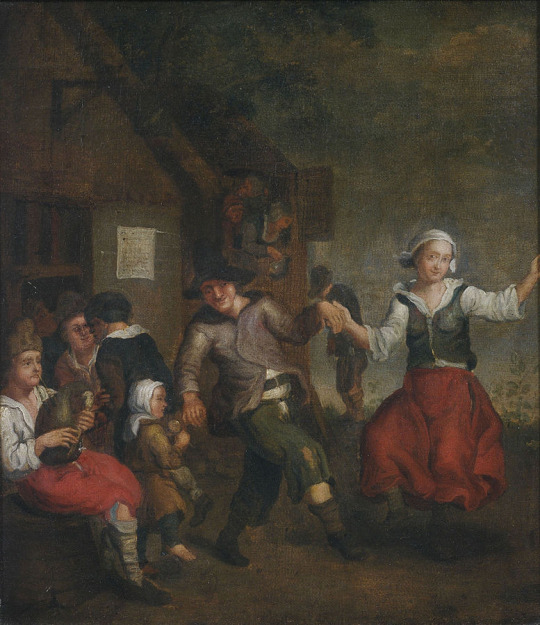
An example of bodies without boning on a peasant woman from the second half of 17th century Netherlands.
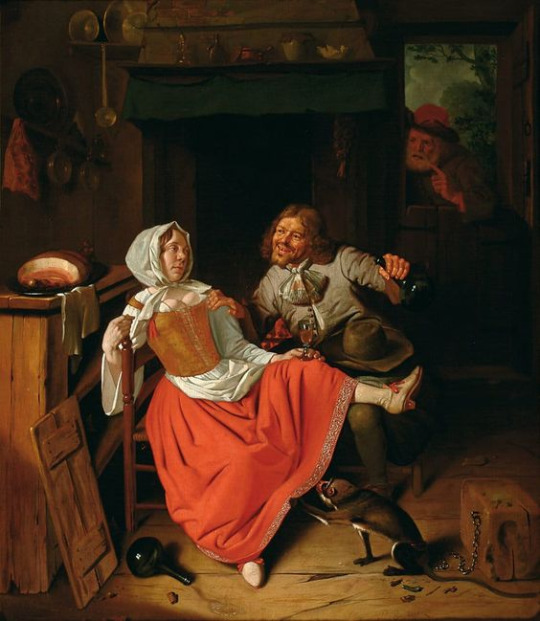
Working class woman with boned bodies from 1665-70, also Netherlands.
In 1680s there was a huge shift in the upper class fashion as mantua, completely unstructured garment, became extremely common and stays were developed from bodies to be it's supportive layer. Before that the boning was called stays, which alludes to the increasing distinction between outer and under clothing, as stays would be more of just separate boning rather than garment that could be used on it's own (though it could still be worn on it's own in some cases). In working class fashion the full petticoat fully disappeared by 18th century and the basic set of clothes was petticoat, supportive bodice without boning or stays (which would become almost universal during the century) and bed gown or jacket. Bed gown was short and very jacket-like, but a looser and t-shaped without the shoulder seem. Both were increasingly used regardless of weather.
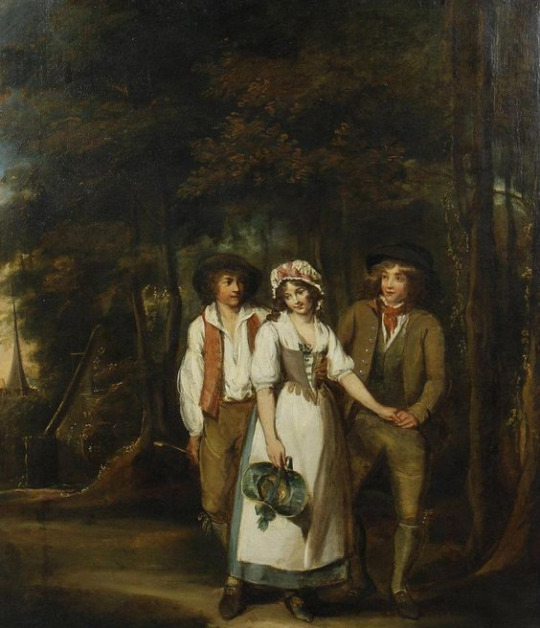
Stays as outer garment from around 1780s-90s.
I think that Mary's blue waistcoat/bodice most resembles 18th century examples. Specifically, the supportive laced bodices without boning, like in the examples below. Unfortunately I haven't found any info about them. The cut is simpler than stays and actually reminds me most about jackets/waistcoats without sleeves. I've read there was laced under-jackets used in 18th century, so I'm wondering if these bodices relates to that. Maybe likelier origin is that they evolved from the previous century working class bodies that didn't have boning. Mary's bodice however is cut very differently. The neckline is high unlike these 1700s bodices, which purpose was to lift the chest.

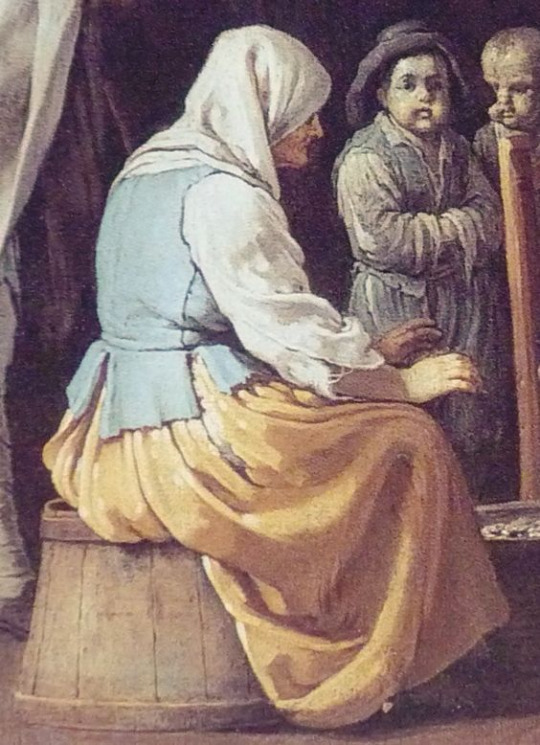
Firstly a Dutch painting from first half of 18th century and then Italian painting from 1721.
Because supportive garments became very much undergarments or at least the second lowest layer right after shift, even if nothing was worn on top of it, it really doesn't fit Mary's bodice. Though I maybe found an exception where stays are possibly worn on top of a sleeved waistcoat or maybe bed gown, but it's hard to say and I haven't seen any other examples of that.

A 1713 Dutch illustration of Brabant, Belgium, dress. The bodice part looks like it could be a bed gown or similar loose jacket-like garment with boned stays on top of it. With little detail and no color it's hard to say though. It could be also a boned jacket or jacket on top of stays.
There is actually a fairly well documented style around this era that does have long sleeved garment beneath and sleeves garment over it. In the latter half of the 17th century and more rarely in early 18th century paintings depict Dutch and Flemish working women wearing long sleeved garment and laced bodice or petticoat over it. I haven't really seen depictions outside of them, however it doesn't mean they don't exist, since as said in the beginning there's just overwhelmingly more lower class depictions in Dutch and Flemish art than in any other art. Still, there being examples of this style from 1700s, when it's very outdated and absent in working class and peasant depictions of art from other areas, where depicting working class is becoming more common, suggests to me that it's at least somewhat regional style.
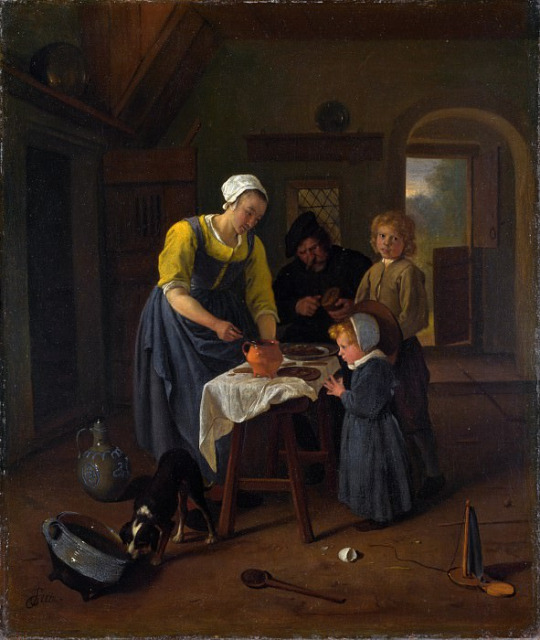
A Dutch painting from circa 1665.
In the above painting the woman seems to wear a full petticoat (the bodice and skirt are same color) with lacing on the front and what seems like a waistcoat under it. It's hard to say if the bodice is boned. This is a nice example as the partlet (the collar had mostly lost popularity by this time) is under garments unlike in most other depictions where it's on top of the bodice. We can then see that the sleeved garment is pinned and has fairly high neckline making it look a lot like the waistcoats of the time. It could be that they are not all the same garment. I would have rather guessed they were full petticoats with sewn-in sleeves before seeing this painting, but some of them still could be, especially the ones that seem more fitted. I haven't found any information about it, except one webside where it was called bed gown, which I think they definitely are not as they come earlier, are sometimes very fitted and often the shoulder seem of the sleeve is shown. Bodies and petticoats with detachable sleeves and waistcoats as over-garments are still frequently found in Dutch and Flemish paintings of the time, which makes me question why would they put especially waistcoat under the supportive layer? My little pet theory is that they need it for the warmth, but they want to protect it with a less expensive petticoat and/or bodies while working.
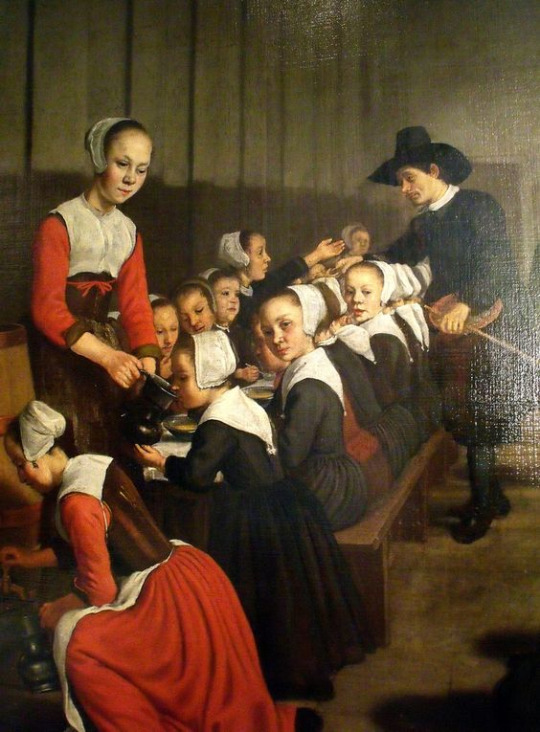
A Dutch 1659-60 painting. Here I think the women in red could be wearing sleeved petticoats or separate bodices under their bodies.
For Mary's outfit the issue is the peplum-type hemline on her blue bodice. It's very much absent in this era from bodies both boned and not, weather because the bodies end in waistline, which there's some depictions of like the one several pictures above, or the hem is under the petticoat. But I did find this one garment from the same era also depicted in Dutch and Flemish art mostly on older women. It has the peplum hem, but it's not bodies. All the examples I've seen are pinned close, so not supportive and definitely not boned. They are also cut differently. The shoulders are quite wide and the neckline high. It almost feels like sleeveless waistcoat. I found even less info on this style, so I can only guess.
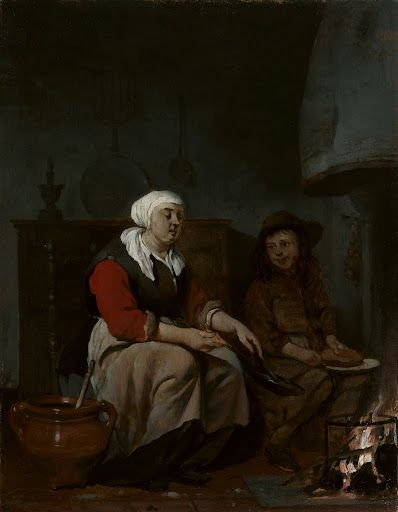
Dutch painting from circa 1650-55. The waistcoat/bodice has a hem here that extends over the gray petticoat unlike with other garments we've looked at.
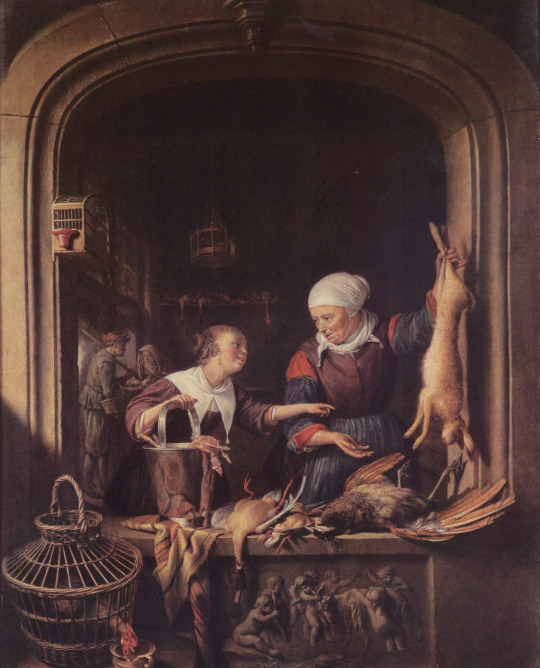
Dutch painting circa 1670. In the enlarge image you can just make out the seem of the undergarment.
I think Mary's clothing best reflects this specific style from this period of time. Her partlet also lacks the ruffle as later 1600s partlets usually do. Her apron is also gathered like those in the latter half of 1600s. Earlier aprons are usually not gathered as seen in the couple of first examples. The blue bodice I think is a mix between the sleeveless waistcoat-type garment seen in two above paintings and the separate or petticoat bodices which are not boned. It's laced and has narrow shoulders like the bodices, but it has high neckline and the hem over the petticoat like the sleeveless "waistcoats". The ruffles on her sleeves don't make sense in this time period. They could make more sense in 1700s. Over all it's actually pretty close in time and geographically to the time and place she's supposed to come from, even if it's not the way she'd actually dress if she was from early 1600s England.
#fashion history#historical fashion#historical clothing#historical costuming#bbc ghosts#working class clothing#peasant clothing#dutch golden age art#baroque#baroque fashion#elizabethan fashion#dress history#answers#ask
122 notes
·
View notes